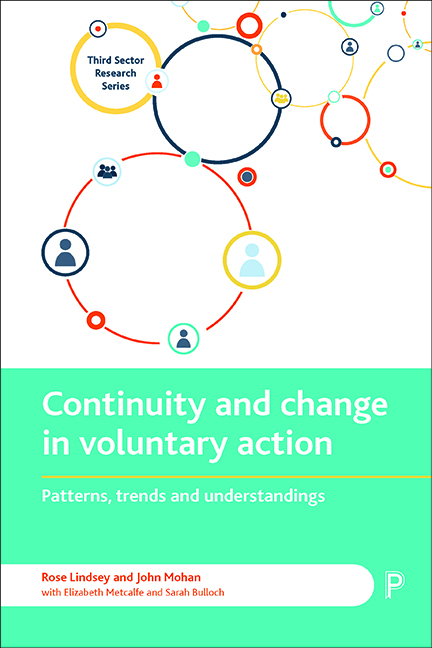Book contents
- Frontmatter
- Contents
- List of figures and tables
- Foreword
- Acknowledgements
- Notes on authors
- Acronyms
- one Introduction
- two The changing policy environment for voluntary action from 1979
- three Data: sources and definitions
- four Trends in volunteering and trends in the voluntary sector
- five Content and context of volunteering
- six Why people volunteer: contextualising motivation
- seven Volunteering trajectories: individual patterns of volunteering over the lifecourse
- eight Attitudes to voluntary action
- nine Conclusions
- Appendix: Anonymised details of writers
- References
- Index
four - Trends in volunteering and trends in the voluntary sector
Published online by Cambridge University Press: 13 April 2022
- Frontmatter
- Contents
- List of figures and tables
- Foreword
- Acknowledgements
- Notes on authors
- Acronyms
- one Introduction
- two The changing policy environment for voluntary action from 1979
- three Data: sources and definitions
- four Trends in volunteering and trends in the voluntary sector
- five Content and context of volunteering
- six Why people volunteer: contextualising motivation
- seven Volunteering trajectories: individual patterns of volunteering over the lifecourse
- eight Attitudes to voluntary action
- nine Conclusions
- Appendix: Anonymised details of writers
- References
- Index
Summary
Introduction
In the research which underpinned William Beveridge's (1948) volume, Voluntary Action, social investigators found that ‘no matter in what sort of area they lived … less than one-third [of respondents] were found to be giving any sort of regular help to people outside their families’ (Beveridge and Wells, 1948, 33). In fact, this was at the higher end of the estimates produced by their local investigators. Seven decades on, regular surveys of volunteering such as the Citizenship Survey (CS), or the subsequent Community Life Survey (CLS), typically find that between 25 and 30 per cent of individuals give unpaid help to organisations outside their households at least once a month. The Beveridge surveyors used a less formalised approach than a modern social survey, but the closeness of the headline figures suggests the intriguing possibility of long-run consistency. What happened, therefore, to volunteering rates during the period in which we are interested? The period has witnessed a combination of an expansion in levels of education (usually thought to be a good predictor of volunteering), a policy environment broadly sympathetic to voluntarism (Chapter Two; Hall, 1999; Kendall, 2003; Alcock, 2010; Hilton et al, 2012), and a steady expansion of the voluntary sector. All of these might be conducive to the growth of volunteering, but what happened in practice?
We begin with a consideration of survey data on volunteering, including statistical evidence from cross-sectional surveys on both formal volunteering for organisations, and on informal neighbourly acts. We consider the broader trends across the period since 1981, as well as evidence of short-term changes within this period. We also utilise longitudinal data from the BHPS, although we rely on that data more fully elsewhere to provide longitudinal profiles for individuals, on the grounds that cross-sectional surveys will underestimate lifetime patterns of involvement.
We flesh this picture out further using Mass Observation Project (MOP) material. This demonstrates how individuals are uncertain about the range of prosocial behaviours that constitute voluntary action; when describing such behaviours (see also Chapter Five), they include a wide range of activities which resist easy characterisation. These rich qualitative descriptions raise questions about whether Mass Observation Project (MOP) respondents would acknowledge the classifications of voluntary action used in social surveys.
- Type
- Chapter
- Information
- Continuity and Change in Voluntary ActionPatterns, Trends and Understandings, pp. 61 - 84Publisher: Bristol University PressPrint publication year: 2018



